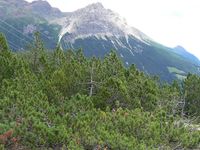List of species
bold
Dominant species, influencing the appearance of the habitat
 Character species
Character species
 Less strictly linked to a specific habitat
Less strictly linked to a specific habitat
| Scientific name | English name |  | Rhododendron hirsutum L. | Bewimperte Alpenrose |  | Arctostaphylos uva-ursi (L.) Spreng. | Immergrüne Bärentraube |  | Cytisus emeriflorus Rchb. | Bergamasker Geissklee |  | Erica carnea L. | Schneeheide |  | Genista radiata (L.) Scop. | Kugel-Ginster |  | Gymnadenia odoratissima (L.) Rich. | Wohlriechende Handwurz |  | Hieracium bifidum aggr. | Gabeliges Habichtskraut |  | Juniperus communis subsp. alpina Čelak. | Zwerg-Wacholder |  | Pinus mugo Turra subsp. mugo | Leg-Föhre |  | Polygala chamaebuxus L. | Buchsblättrige Kreuzblume |  | Rubus saxatilis L. | Steinbeere |  | Sesleria caerulea (L.) Ard. | Kalk-Blaugras |  | Tofieldia calyculata (L.) Wahlenb. | Kelch-Simsenlilie |
|---|
Status
Status according to the habitat priority list at the national level
| National Priority | K: no national priority |
| Need to take action | 0: mesures needed |
| International responsibility | 1: weak |
Status on national Red List 2016
IUCN status: Least concern

Additional information
IUCN criteria: --
- Legend
CO Collapsed CR Critically Endangered EN Endangered VU Vulnerable NT Near Threatened LC Least Concern
Legal protection (NCHO appendix 1)
Natural habitat worthy of protection
Regeneration status 2016
| Regeneration class | 4: 25 to 50 years |
